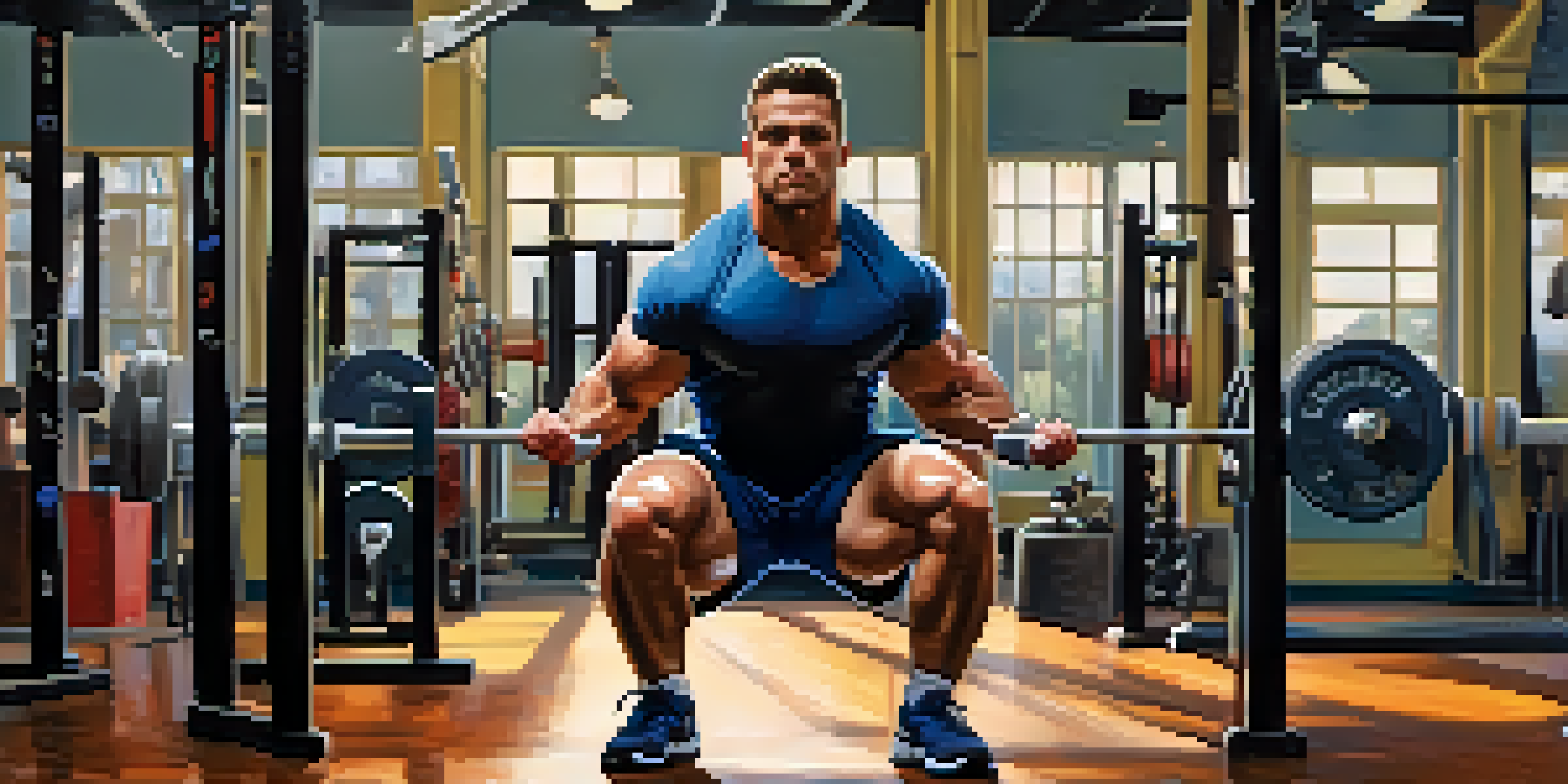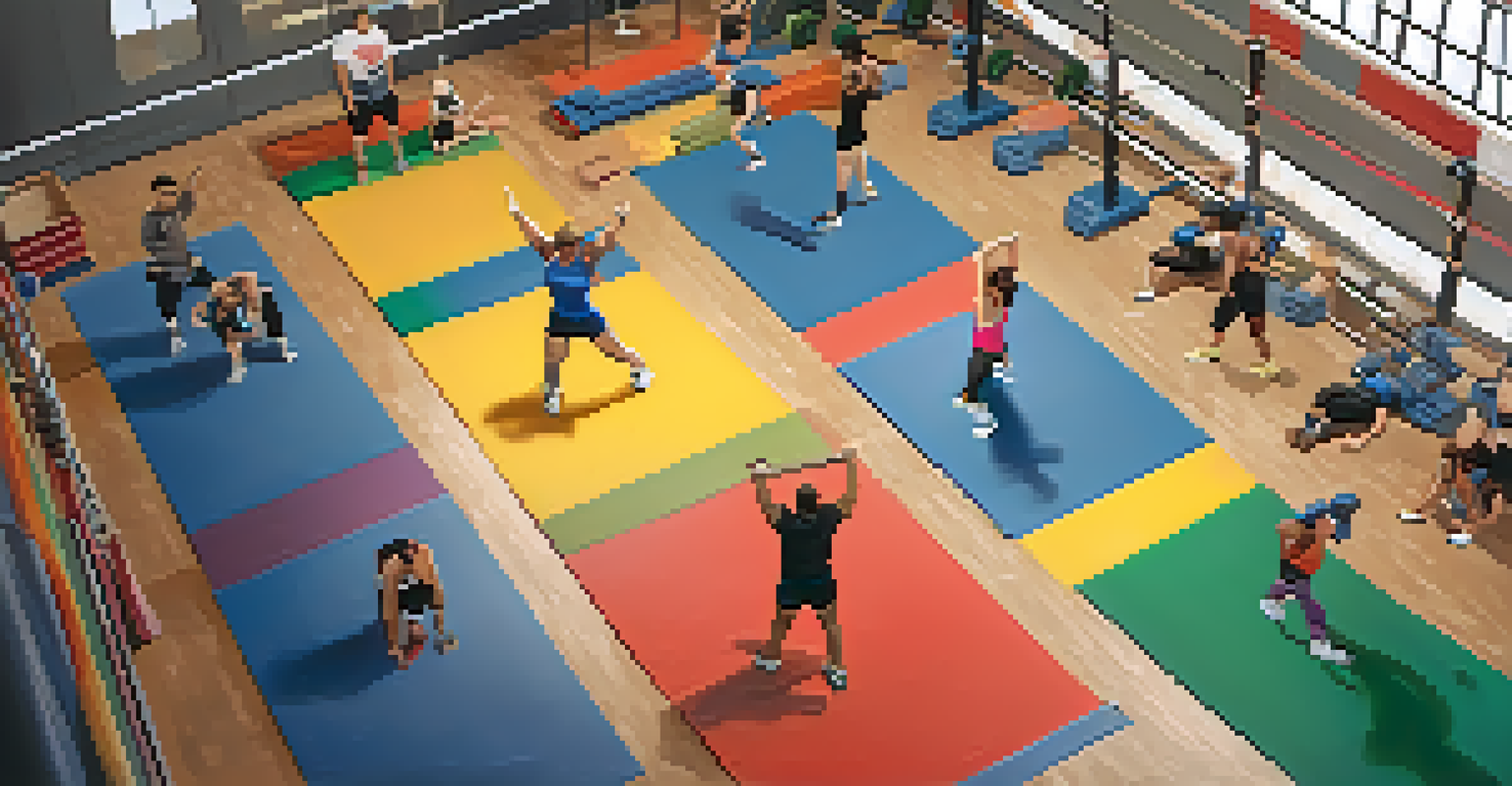Dynamic Warm-Ups to Boost Powerlifting Performance Effectively

Understanding Dynamic Warm-Ups in Powerlifting
Dynamic warm-ups are active movements that prepare your muscles and joints for the rigors of lifting. Unlike static stretches, which can relax muscles, dynamic movements help to increase blood flow and improve range of motion. This is crucial in powerlifting, where every ounce of strength and flexibility counts.
The more you sweat in training, the less you bleed in battle.
These warm-ups mimic the movements you’ll perform during your workout, making them particularly effective. For powerlifters, this means incorporating exercises that engage the legs, hips, and core. By replicating these motions, you signal to your body that it’s time to get serious about lifting.
In essence, dynamic warm-ups set the stage for optimal performance. They not only enhance physical readiness but also mentally prepare you for the challenges ahead. When done correctly, a good warm-up routine can significantly impact your lifts.
Benefits of Dynamic Warm-Ups for Lifters
Dynamic warm-ups come with a plethora of benefits that are especially relevant for powerlifters. One major advantage is improved muscle activation, which means your body can generate more force during lifts. This heightened state of readiness can lead to better performance and increased lifts.

Additionally, these warm-ups help reduce the risk of injury by preparing the muscles and joints for the stresses they'll face. By increasing blood flow and flexibility, dynamic routines can help prevent strains and other common injuries. This is vital for powerlifters, as even a minor injury can set back months of progress.
Dynamic Warm-Ups Boost Performance
Incorporating dynamic warm-ups enhances muscle activation and prepares your body for the demands of powerlifting.
Furthermore, dynamic warm-ups can enhance mental focus. This moment of preparation allows athletes to clear their minds and concentrate on their goals for the session. A focused mindset is just as important as physical readiness in the realm of powerlifting.
Key Components of an Effective Dynamic Warm-Up
An effective dynamic warm-up should include movements that target all major muscle groups used in powerlifting, particularly the squat, bench press, and deadlift. Think of exercises like leg swings, arm circles, and torso twists. These movements are designed to promote mobility and flexibility.
Success is where preparation and opportunity meet.
It's also essential to integrate sport-specific drills that mimic the lifts you will perform. For instance, incorporating bodyweight squats or push-ups can prepare your muscles for heavier loads. This tailored approach ensures that your warm-up aligns with your lifting goals.
Lastly, the duration of your warm-up matters. Aim for at least 10-15 minutes to adequately prepare your body. This timeframe allows for the gradual increase in heart rate and muscle readiness, ensuring you’re fully primed for lifting.
Examples of Dynamic Warm-Up Exercises for Powerlifters
When it comes to dynamic warm-ups, variety is key. A few effective exercises include high knees, butt kicks, and walking lunges. These movements not only engage multiple muscle groups but also elevate your heart rate, preparing you for the workout ahead.
Another great addition is the inchworm stretch, which works your hamstrings while also engaging your core. This exercise is particularly beneficial for deadlift preparation, as it encourages proper form and flexibility. Incorporating a mix of exercises ensures a comprehensive warm-up.
Injury Prevention Through Warm-Ups
These warm-ups reduce the risk of injury by increasing blood flow and flexibility, crucial for powerlifters.
Lastly, don’t forget about mobility drills. Movements like hip circles and ankle rolls can help improve joint mobility, which is crucial for maintaining proper lifting techniques. A well-rounded warm-up should address all aspects of physical preparation.
How Long Should a Dynamic Warm-Up Last?
The length of your dynamic warm-up can vary, but generally, 10-15 minutes is recommended. This allows enough time to engage all major muscle groups and elevate your heart rate. Rushing through your warm-up can lead to insufficient preparation, which might hinder performance.
A good rule of thumb is to spend roughly one minute on each exercise, allowing for adequate movement and engagement. Adjust the duration based on your personal needs and the intensity of your workout. If you’re preparing for a particularly challenging session, consider extending your warm-up.
Listening to your body is essential—if you feel tight or tense, spend additional time on specific areas. Remember, the goal is to feel mobile and ready to tackle your lifts, so prioritize quality over quantity.
Incorporating Dynamic Warm-Ups into Your Routine
Integrating dynamic warm-ups into your routine doesn't have to be complicated. Start by dedicating a few minutes before each lifting session to perform your warm-up exercises. Consistency is key; over time, you'll notice the positive effects on your performance.
Consider creating a go-to warm-up routine that you can easily repeat. This could include a mix of leg swings, lunges, and mobility drills tailored to your needs. Having a structured warm-up not only saves time but also ensures that you hit all essential areas.
Customize Your Warm-Up Routine
Tailoring your dynamic warm-up to your specific lifting goals ensures optimal preparedness for each session.
Lastly, don’t forget to adjust your routine based on your specific workout plans. If you’re focusing on squats one day, prioritize exercises that activate your legs and hips. Customizing your warm-up will ensure that you’re always prepared for what’s to come.
Monitoring Progress and Adjusting Your Warm-Up
As with any aspect of training, it’s important to monitor how your body responds to your dynamic warm-up routine. Pay attention to how you feel during your lifts—do you notice improved performance and reduced tightness? Keeping track of these changes can help you refine your warm-up strategy over time.
If you find certain exercises aren’t yielding the desired results, don’t hesitate to switch it up. Experiment with different movements or modify the intensity to see what works best for you. This adaptability is key in optimizing your warm-up and overall performance.

Ultimately, the goal is to find a dynamic warm-up routine that enhances your lifting experience. By staying attuned to your body and making necessary adjustments, you’ll be well on your way to achieving your powerlifting goals.